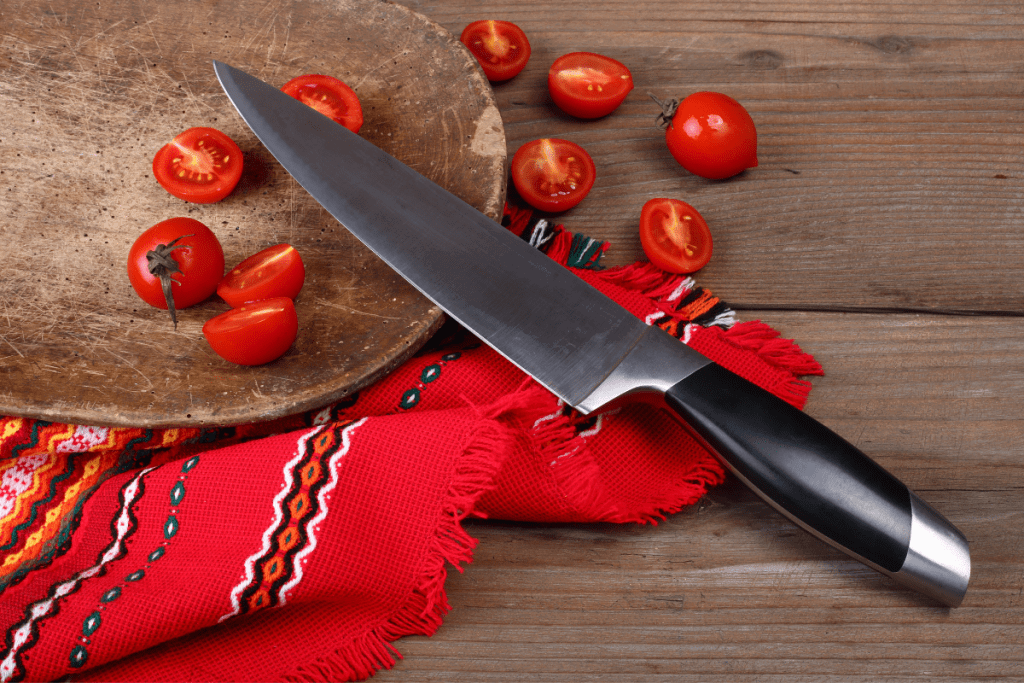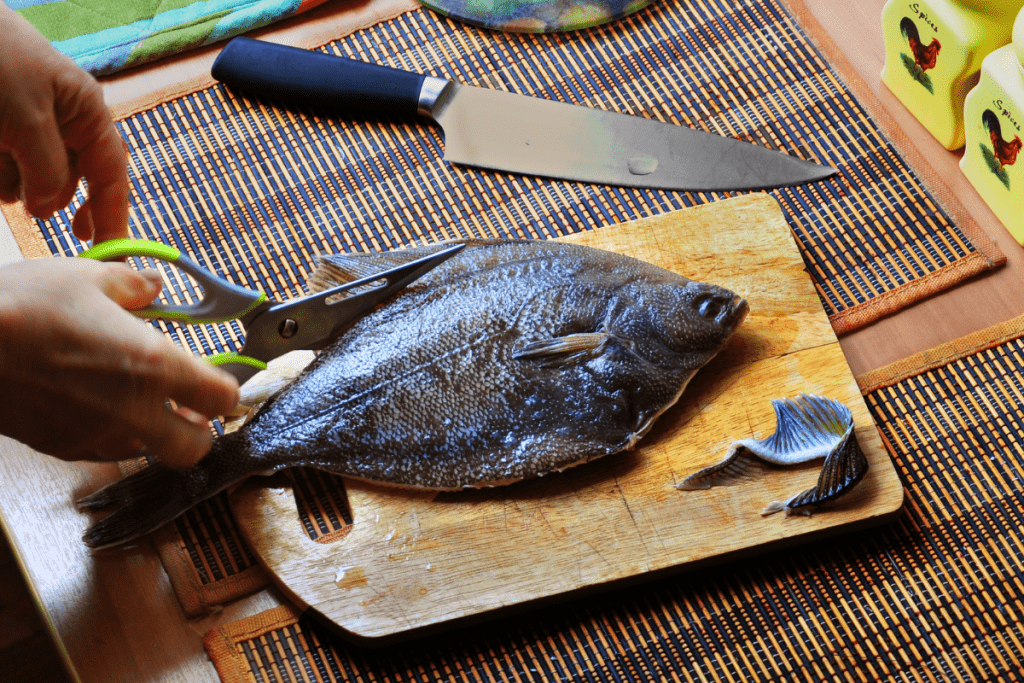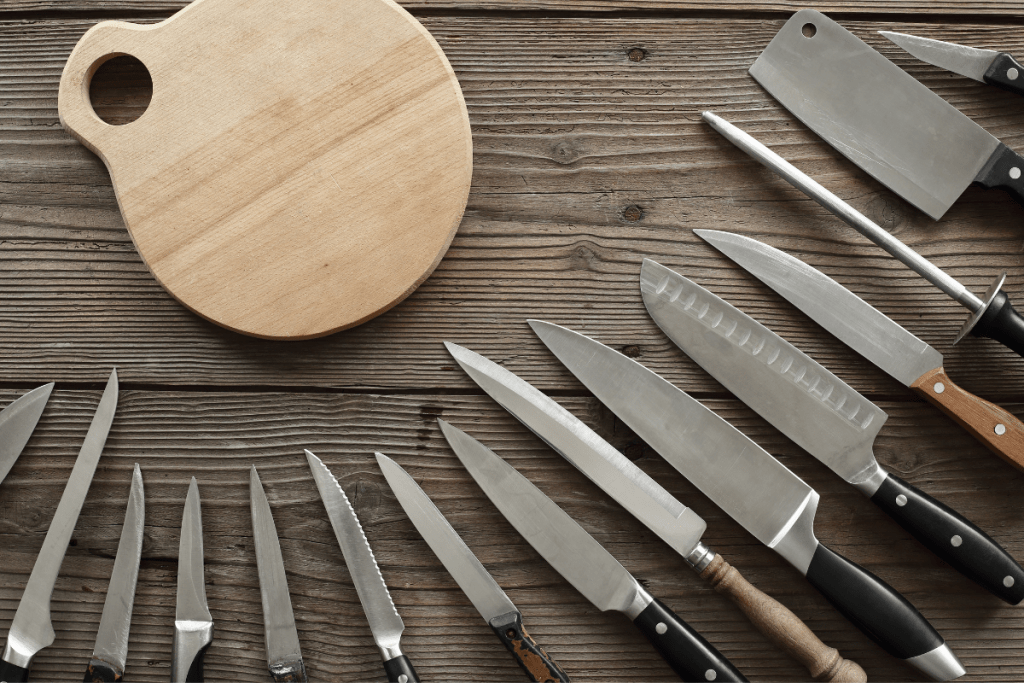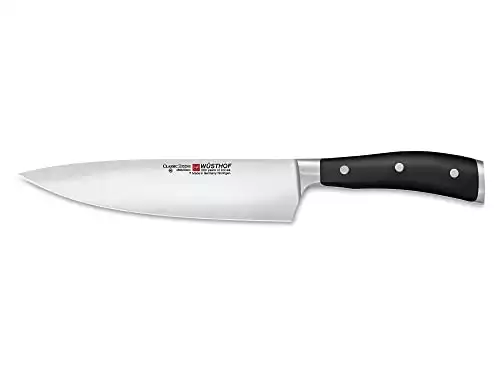Setting up your chopping block can be a challenge. There are dozens of knives to choose from, with prices that range from a couple of bucks to a few hundred dollars apiece.
At some point, we’re all bound to feel a bit overwhelmed. It’s the blessing and curse that comes with loving to cook. If you’re reading this article at a “what knives do I need” moment in your life, I’ll say this upfront – time and experience are the only true remedies.
With that said, I hope that sharing my own experiences can speed up that process for you. After working in professional kitchens for over a decade, I have a wealth of hands-on knowledge with every manner of kitchen knives.
In this guide, you’ll learn about the five most essential knives and why each one deserves a place in your kitchen.
In This Article
The Chef’s Knife: King of the Kitchen

A full 80% of the cutting, chopping, and slicing that you do in a kitchen should be courtesy of a chef’s knife. It’s the go-to tool for everything from slicing vegetables to chopping chicken breasts and mincing garlic. No home or professional chef should be without one!
Chef’s knives come with blade lengths from 8 to 12 inches. In my experience, 8 inches gives you more than enough blade to work with. Any chef’s knife larger than that will feel unwieldy for beginner or intermediate cooks.
When you’re budgeting for essential knives to buy for your kitchen, focus most of your money on getting the best quality chef’s knife that you can. It’s not uncommon to spend over $100 on a high-quality chef’s knife. In return, you’ll get a knife that you’ll be able to pass down to your kids. And if you take care of it well, that knife will be just as sharp as the day you got it.
You’ll need to choose between two main styles of chef’s knives:
- Western-style chef’s knives are usually made of softer steel. They’re more durable but slightly less sharp than Japanese knives. They have the advantage of being stain-free, though.
- Japanese knives are made of harder steel. This gives a sharper edge, but also makes them prone to chipping. They need to be oiled regularly to prevent rust.
For an in-depth look at the differences, please check out my guides to the best Japanese knives and best German knives.
My Recommendation: Wusthof Classic Ikon 8-Inch Chef’s Knife Or Miyabi 8-Inch Chef’s Knife
The Paring Knife: An Ideal Sidekick

For precise and detailed cuts, there’s no better knife to use than a paring knife. Where a chef’s knife will do the heavy lifting in your kitchen, a paring knife will give you the ability to make finely tuned cuts. This especially includes peeling fruits and vegetables, a task that the chef’s knife is not cut out for.
Paring knives have blades that measure between 3 and 4 inches. They come in three main styles:
- Classic paring knives are shaped just like a chef’s knife, but smaller. They’re my first choice for beginners, as they’re very easy to handle.
- Sheep’s foot paring knives have a flat blade edge and a rounded curve at the tip. The sheep’s foot paring knife works well on cutting boards, but is harder to use mid-air.
- Bird’s beak paring knives are curved through to the tip. Professional French chefs use them for detailed peeling and pitting, two functions that a home cook won’t often need.
Because you won’t be using it as often as a chef’s knife, don’t worry about spending as much on a paring knife. You can buy a high-quality paring knife for under $50. Anything more than that, and you’re just paying for looks.
My Recommendation: Wusthof Classic High Carbon Steel Paring Knife
The Cleaver: Getting Down to Business

Even the heaviest chef’s knife will struggle with breaking down a whole chicken or deboning a roast. For the toughest jobs in the kitchen, you’ll need to turn towards the trusty cleaver. Also known as a butcher’s knife, these heavy blades are specially designed to handle what thinner blades cannot.
Cleaver blades measure between 6 and 10 inches, and come in a wide range of shapes. What they all have in common, though, is a thick and heavy blade. The thicker steel lets a cleaver do more work for you, and keeps it from getting damaged when it runs into bones.
You can easily spend as much on a cleaver as you would on a chef’s knife, but that’s unnecessary. Why? Let me tell you my shameful kitchen knife secret: any cleaver is going to get beat up while you’re using it. Often, that can damage the blade to a point where it’s next to impossible to sharpen again.
So instead of spending a lot on a blade that will probably get damaged at some point, I use the $20 cleavers that you can find at almost any Asian market. They’re heavy, sharp, and cheap, and I usually get a few years out of each knife before needing to replace them. Just don’t tell my fancy chef friends, okay?
My Recommendation: Winco Blade Chinese Cleaver
The Serrated Knife: The Best Thing for Slicing Bread

Everyone should get to experience the joy of freshly baked bread right out of the oven. But please, don’t make the same mistake I did after that golden loaf is ready to slice. No matter how much you might wish it were so, using a chef’s knife is a terrible way to cut bread. Only a serrated blade is up to the task.
Do yourself a favor and pick up an inexpensive serrated knife for your kitchen. It won’t see much use outside of slicing bread and bagels, but no other knife works well for those tasks. Look for a 6 to 8-inch serrated knife, and don’t spend more than about $30 on it. Then set it aside and only use it for cutting baked goods so it retains a sharp edge.
My Recommendation: Henckels Statement Bread Knife
Kitchen Shears: Quick and Easy Trimming

Scissors aren’t knives, you say? Pshaw! Ever since I added a pair of kitchen shears to my knife rack, I’ve found them to be a wonderful alternative to full-sized knives. When you don’t want to go to the trouble of getting a cutting board out, kitchen shears will let you quickly chop, trim, and cut with ease.
Don’t go using just any scissors in your kitchen, though. Proper kitchen shears separate at the joint, allowing you to pull them apart and fully sanitize them. If they can’t come apart, you don’t want them in your kitchen.
A great pair of kitchen shears will cost under $20, too. That makes them an affordable addition for anyone who regularly uses fresh herbs and veggies in their recipes.
My Recommendation: OXO’s Good Grips kitchen shears
The Rest of the Cast: Other Knives You Might Want
Boning knife, carving knife, santoku, nakiri, steak knives.
I have a confession to make: For years, the only knives I had in my home kitchen were a chef’s knife and a paring knife. It took me nearly a decade to add the cleaver, serrated knife, and kitchen shears that I recommend above. But once that gate was open, I realized just how nice it could be to have a wider selection of knives to choose from.
In the spirit of encouraging you to further explore your own kitchen skills, here are five other knives that are worth considering for your collection.
- A santoku knife is a real kitchen all-rounder. They’re easily capable of standing in for a chef’s knife. If you regularly cook with a friend or partner, add one of these so you both have an all-purpose knife to use.
- A nakiri knife specializes in cutting vegetables. These thin, blocky blades are an excellent addition for anyone who enjoys vegetarian meals. They’re lightweight and easy to use for cutting onions, garlic, carrots, potatoes, etc.
- A set of steak knives with sharp stainless steel blades make for excellent serving ware. Most knife blocks have extra slots for storing them, too.
- A boning knife will let you prepare the freshest cuts of fish possible. Boning knives are great for separating small bones in poultry, too.
- A carving knife is a constant companion to holiday meals. Thanksgiving turkeys, Easter roasts, and Christmas hams all benefit from this knife’s ability to carve thin slices.
Conclusion: Choosing Your Essential Kitchen Knives
That’s a wrap on which knives I find to be best for the home kitchen. At this point, you’re well aware of what knives you need for your kitchen. How many of them do you already have? Which kitchen knives do you plan to pick up for your home?
You can read up more on the details of each knife in our guide to the 13 types of knives you may want for your kitchen. From there, check out our in-depth review of the best carbon steel knives if you’re looking for the best chef’s knife available. Or if you’d like to get your whole knife set in one fell swoop, take a look at our complete Wusthof knives review.
I’d love to hear what knives work best in your kitchen, and any costly detours you’ve taken in the journey toward building your knife collection. Drop us a line in the comments below to ask a question, share a story and add your experience!








